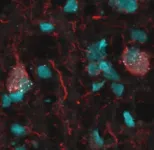(Press-News.org) By A.J. Hostetler
Led by the director of Virginia Commonwealth University’s Stravitz-Sanyal Institute of Liver Disease and Metabolic Health, a consortium studying noninvasive tests for liver disease has demonstrated the effectiveness of five noninvasive tests, a significant milestone on the path to regulatory approval.
In an article published today in the journal Nature Medicine, institute director Arun Sanyal, M.D., a professor at the VCU School of Medicine, and colleagues report on five biomarker tests that potentially could be given to patients who may have metabolic dysfunction-associated steatohepatitis, or MASH.
The research to evaluate blood and imaging biomarker tests for liver disease is part of NIMBLE – the Noninvasive Biomarkers of Metabolic Liver Disease project, a public-private partnership involving the Foundation for the National Institutes of Health, the Food and Drug Administration, academic researchers and industry partners. Sanyal, who is the first author of the Nature Medicine paper, chairs the FNIH Biomarkers Consortium NIMBLE program.
Although several companies have developed such tests, none has yet met the requirements needed for FDA regulatory approval.
Finding alternatives to liver biopsy is critical, Sanyal says.
“Currently, diagnosing early-stage MASH requires a liver biopsy, which is a painful, invasive and expensive process for patients. MASH is a serious disease, and once the liver starts to scar up, the risk of cirrhosis, liver cancer and death rises, often leaving transplant the only treatment option for patients,” he said.
MASH, formerly known as NASH, is often called a “silent disease,” because patients do not display symptoms until later stages of the condition, when they develop cirrhosis. There are no FDA-approved treatments for MASH, which affects about 5% of the U.S. population. About 20% of patients with MASH will progress to cirrhosis, which may require a transplant.
“Dr. Sanyal’s leadership of the NIMBLE project has been invaluable as we move toward our goal of fully qualifying noninvasive biomarkers through the FDA,” said Tania Kamphaus, Ph.D., a co-author of the paper and FNIH’s director of translational science, metabolic disorders as well as patient engagement. “The initial study findings demonstrate that these tests have the potential to enable breakthrough discoveries in developing new treatments for patients with liver disease.”
The NIMBLE biomarker tests were compared to standard measures, such as the FIB-4, an index used to gauge liver health developed by Richard Sterling, M.D., clinical director at the liver institute and a professor of medicine in the School of Medicine’s division of gastroenterology, hepatology and nutrition and its division of infectious disease. Each biomarker test that met or exceeded the performance of current lab tests was evaluated for use in diagnosing MASH and related conditions among the more than 1,000 patients who participated in the newly published research.
Currently, the only way to test patients for MASH is through liver biopsies, which provide information only from that small section of the 3-pound organ and may not give an accurate overall picture of a patient’s disease.
Having accurate biomarker tests for MASH is expected to encourage patients to participate in future clinical trials, which would otherwise require liver biopsies. Using noninvasive blood tests may also significantly reduce costs of such studies, increasing interest in drug development. Equally as important, the tests could be easily ordered in a doctor’s office.
“This brings us a step closer to having simple blood-based tests that can be ordered virtually in any clinical setting and will provide access to care to patients,” Sanyal said. “Such a step will facilitate our ability to identify those most at risk of outcomes and target them for therapy. It will also serve as a foundation for prognostic, disease monitoring and treatment-response biomarker development.”
Sanyal says individuals who are overweight or have type 2 diabetes or high blood pressure should talk with their physician about whether they are at risk of liver disease and what they can do to lower that risk, such as losing weight and taking other measures for a healthier lifestyle.
END
VCU liver institute director leads review of noninvasive tests that could be alternatives to painful biopsies
New diagnostic tools using disease biomarkers could also lower costs and spur more clinical trials
2023-09-07
ELSE PRESS RELEASES FROM THIS DATE:
Early access to testosterone therapy in transgender and gender-diverse adults seeking masculinization
2023-09-07
About The Study: In this randomized clinical trial including 64 transgender and gender-diverse adults, immediate testosterone therapy compared with no treatment significantly reduced gender dysphoria, depression, and suicidality in transgender and gender-diverse individuals desiring testosterone therapy.
Authors: Ada S. Cheung, M.B.B.S., Ph.D., of Austin Health in Heidelberg, Victoria, Australia, is the corresponding author.
To access the embargoed study: Visit our For The Media website at this link https://media.jamanetwork.com/
(doi:10.1001/jamanetworkopen.2023.31919)
Editor’s Note: Please see the article for ...
Analysis of heat exposure during pregnancy and severe maternal morbidity
2023-09-07
About The Study: Long- and short-term heat exposure during pregnancy was associated with higher risk of severe maternal morbidity in this study with 403,000 pregnancies from 2008 to 2018 in Southern California. These results might have important implications for severe maternal morbidity prevention, particularly in a changing climate.
Authors: Jun Wu, Ph.D., of the University of California, Irvine, is the corresponding author.
To access the embargoed study: Visit our For The Media website at this link https://media.jamanetwork.com/
(doi:10.1001/jamanetworkopen.2023.32780)
Editor’s Note: Please ...
Calcium channel blocker use and associated glaucoma and related traits
2023-09-07
About The Study: Calcium channel blocker use was adversely associated with glaucoma prevalence in this study of 427,000 adult UK Biobank participants, suggesting that calcium channel blockers may represent an important modifiable risk factor for glaucoma, potentially through an intraocular pressure–independent mechanism.
Authors: Alan Kastner, M.D., M.Sc., of the Moorfields Eye Hospital National Health Service Foundation Trust and University College London Institute of Ophthalmology in London, is the corresponding author.
To access the embargoed study: Visit our For The Media website at this link https://media.jamanetwork.com/
(doi:10.1001/jamaophthalmol.2023.3877)
Editor’s ...
Phase I clinical trial shows treatment designed to clear senescent cells in Alzheimer’s disease is safe
2023-09-07
WINSTON-SALEM, N.C. – Sept. 7, 2023 – Alzheimer’s disease is the most common cause of dementia that affects more than 6.5 million Americans, according to the Alzheimer’s Association. To find effective treatments and slow the progression of this debilitating disease, researchers have made much progress in developing new drugs that target beta-amyloid plaques, one of the hallmarks of Alzheimer’s disease.
Beta-amyloid plaques are accumulations of brain protein fragments, which can impact cognition. However, these recent drugs have only yielded modest results.
Now, ...
Ravenous black hole consumes three Earths’-worth of star every time it passes
2023-09-07
A star like our own Sun in a nearby galaxy is gradually being eaten away by a small but ravenous black hole, losing the equivalent mass of three Earths every time it passes close.
The discovery by University of Leicester astronomers is reported today (7 September) in Nature Astronomy and provides a ‘missing link’ in our knowledge of black holes disrupting orbiting stars. It suggests a whole menagerie of stars in the process of being consumed that still lie undiscovered.
The team was supported by the UK Space Agency and the UK Science and technology Facilities Council (STFC).
The astronomers were alerted to ...
MIT engineers design more powerful RNA vaccines
2023-09-07
CAMBRIDGE, MA -- RNA vaccines against Covid-19 have proven effective at reducing the severity of disease. However, a team of researchers at MIT is working on making them even better. By tweaking the design of the vaccines, the researchers showed that they could generate Covid-19 RNA vaccines that produce a stronger immune response, at a lower dose, in mice.
Adjuvants are molecules commonly used to increase the immune response to vaccines, but they haven’t yet been used in RNA vaccines. In this study, the MIT researchers engineered both the nanoparticles used to deliver the Covid-19 antigen, and the antigen itself, to boost the immune response, ...
Genetic tools probe microbial dark matter
2023-09-07
Patescibacteria are a group of puzzling, tiny microbes whose manner of staying alive has been difficult to fathom. Scientists can cultivate only a few types, yet these bacteria are a diverse group found in many environments.
The few types of Patescibacteria that researchers can grow in the lab reside on the cell surfaces of another, larger host microbe. Patescibacteria in general lack the genes required to make many molecules necessary for life, such as the amino acids that make up proteins, the fatty acids that form membranes, and the nucleotides in DNA. This has led researchers ...
Revolutionizing lithium production on a string
2023-09-07
A vital component of the batteries at the heart of electric vehicles and grid energy storage, lithium is key to a clean energy future. But producing the silvery-white metal comes with significant environmental costs. Among them is the vast amount of land and time needed to extract lithium from briny water, with large operations running into the dozens of square miles and often requiring over a year to begin production.
Now, researchers at Princeton have developed an extraction technique that slashes the amount of land and time needed for lithium production. The researchers say their system ...
Genetic study of blood glucose levels calls for stratified treatment with GLP-1R agonists in type 2 diabetes, reveals the role of the intestine, and impact on lung function
2023-09-07
New research highlights that genetic background can affect individual responses to GLP-1R agonist drugs.
Researchers reveal for the first time that high blood sugar levels in type 2 diabetes can play a causal role in lung disorders.
The study sheds light on the role of the digestive system, including the small intestine, ileum, and colon, in controlling blood sugar levels.
This is the largest-ever study into the genetic basis of random "round-the-clock" blood sugar levels.
Groundbreaking research published today in Nature Genetics describes the largest-ever study into the genetics of random "round-the-clock" ...
Bursting air bubbles may play a key role in how glacier ice melts, Oregon State research suggests
2023-09-07
CORVALLIS, Ore. – Oregon State University research has uncovered a possible clue as to why glaciers that terminate at the sea are retreating at unprecedented rates: the bursting of tiny, pressurized bubbles in underwater ice.
Published today in Nature Geoscience, the study shows that glacier ice, characterized by pockets of pressurized air, melts much more quickly than the bubble-free sea ice or manufactured ice typically used to research melt rates at the ocean-ice interface of tidewater glaciers.
Tidewater glaciers are rapidly retreating, the authors say, resulting in ice mass loss in Greenland, the Antarctic Peninsula and other glacierized regions around the globe.
“We ...
LAST 30 PRESS RELEASES:
Numbers in our sights affect how we perceive space
SIMJ announces global collaborative book project in commemoration of its 75th anniversary
Air pollution exposure and birth weight
Obstructive sleep apnea risk and mental health conditions among older adults
How talking slows eye movements behind the wheel
The Ceramic Society of Japan’s Oxoate Ceramics Research Association launches new international book project
Heart-brain connection: international study reveals the role of the vagus nerve in keeping the heart young
Researchers identify Rb1 as a predictive biomarker for a new therapeutic strategy in some breast cancers
Survey reveals ethical gaps slowing AI adoption in pediatric surgery
Stimulant ADHD medications work differently than thought
AI overestimates how smart people are, according to HSE economists
HSE researchers create genome-wide map of quadruplexes
Scientists boost cell "powerhouses" to burn more calories
Automatic label checking: The missing step in making reliable medical AI
Low daily alcohol intake linked to 50% heightened mouth cancer risk in India
American Meteorological Society announces Rick Spinrad as 2026 President-Elect
Biomass-based carbon capture spotlighted in newly released global climate webinar recording
Illuminating invisible nano pollutants: advanced bioimaging tracks the full journey of emerging nanoscale contaminants in living systems
How does age affect recovery from spinal cord injury?
Novel AI tool offers prognosis for patients with head and neck cancer
Fathers’ microplastic exposure tied to their children’s metabolic problems
Research validates laboratory model for studying high-grade serous ovarian cancer
SIR 2026 delivers transformative breakthroughs in minimally invasive medicine to improve patient care
Stem Cell Reports most downloaded papers of 2025 highlight the breadth and impact of stem cell research
Oxford-led study estimates NHS spends around 3% of its primary and secondary care budget on the health impacts of heat and cold in England
A researcher’s long quest leads to a smart composite breakthrough
Urban wild bees act as “microbial sensors” of city health.
New study finds where you live affects recovery after a hip fracture
Forecasting the impact of fully automated vehicle adoption on US road traffic injuries
Alcohol-related hospitalizations from 2016 to 2022
[Press-News.org] VCU liver institute director leads review of noninvasive tests that could be alternatives to painful biopsiesNew diagnostic tools using disease biomarkers could also lower costs and spur more clinical trials




